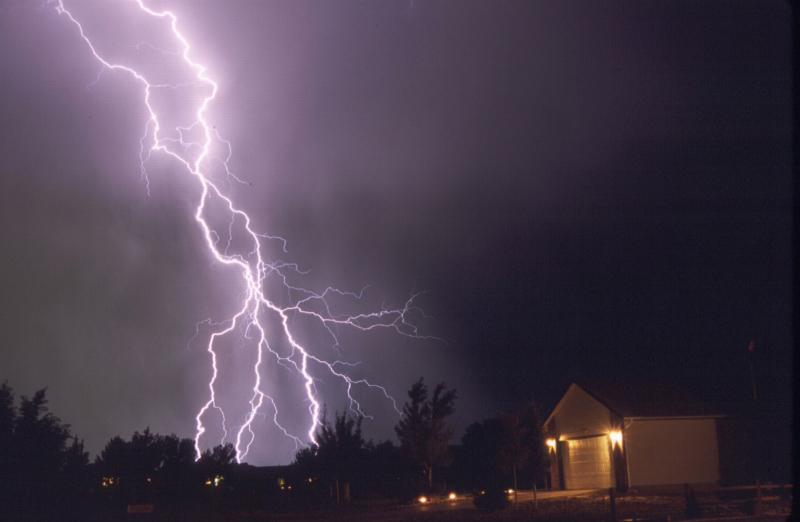Many of us have probably experienced a time when an electrical device was fried due to a voltage spike -- also known as a power surge. This is obviously a frustrating and often costly experience. So what causes these power surges, and what can we do to protect our property from their damaging effects?
Most Common Causes of Power Surges:
Lightning is a powerful force of nature and does not have to directly strike your house to wreak havoc. A nearby lightning strike can be just as damaging to electrical devices in your home. Lightning can also enter through the electrical, cable, phone, or water lines connected to your house.
Surges can also come directly from the electric utility lines during power outages, during switching on the electric system, or when equipment at other homes or businesses is turned on or off or operated in ways other than intended. Power outages are triggered by event such as storms, trees, animals, and vehicle accidents. Often during these events, power lines are contacting other lines or the ground and causing voltage spikes that can lead to power surges. These surges at times can be quite severe. When the power comes back on after an outage, the system is in an unstable state for a short period of time and voltages and currents on the system can spike until the system settles down to normal operating levels (similar to your car bouncing up and down after hitting a large pothole).
Surges also often come from within your own home. Motors and compressors turning on and off or failing equipment can cause power surges to be experienced. Large surges can cause instantaneous damage; however, small surges over a period of time can be just as damaging -- even if not as dramatic -- through degrading of circuitry to the point of failure.

Your Cooperative's Role in Protecting Against Surges
Washington Electric Cooperative installs devices and surge arrestors on our system to help protect equipment -- both ours and yours -- from surges. It is always a balance when protecting equipment between minimizing the number of outages experienced and providing maximum protection. For example, the more sensitive we set our protective equipment, the greater protection we can provide against surges, but the quicker the power will go out when a tree branch or squirrel temporarily contacts one of our lines. We try to find the best balance to keep the lights on and at the same time protect those lights from blowing during a surge. We also have regular maintenance programs to keep our equipment in good working order and a right-of-way program in which we invest heavily to control tree-related outages.
Your Role in Protecting Against Surges
There are several ways to safeguard your home against power surges. The first and easiest is to use power strips with surge protection to plug in sensitive electronic equipment.
A word of caution is needed here: Not all power strips provide surge protection!
You can know your power strip provides surge protection if it has an energy absorption/dissipation rating. Power surges are measured in joules, and surge protectors are rated for the number of joules they can effectively absorb. If your surge protector is rated at 1,000 joules, it should be replaced when it hits or passes that limit. When the limit is reached, protection stops, and you're left with a basic power strip. Some surge protectors include indicator lights to warn you when they've stopped working as designed, but many do not. If your electric system takes a major hit, or if you don't remember when you bought your surge protector, replacement is the best option.
Of course, not all electrical devices can be plugged into a surge protector. Lights, HVAC units, and other electric appliances may be hard wired directly into your electrical panel. To provide surge protection for these devices, we recommend that you consult with an electrician to:
- Install appropriate "whole house" surge protection
- Ensure proper grounding is in place at your electrical service entrance
- Upgrade inadequate wiring or fix overloaded electrical circuits
It is important even if you have installed whole house surge protection to continue to use surge protectors on sensitive electronic devices to protect from internal surges and to provide a second layer of protection right at these devices.
Another easy way to help protect against power surges from the electric system is to turn off appliances, HVAC units, TVs, computers, and other sensitive electronics during a power outage. This will help avoid damage from a power surge when the power is restored and will also help the system to stabilize quicker. This can be taken one step further by simply leaving devices not commonly used unplugged all the time. This can also help to improve electrical efficiency by reducing "phantom loads" that draw power while plugged in even if not being used.
Finally, most homeowner's insurance policies cover losses from power surges. Make sure you are familiar with your policy, what is covered, and your deductible levels to prove the best balance of coverage for your specific situation.
Electricity is an essential necessity for modern living, and Washington Electric Cooperative is committed to providing safe, reliable, and affordable power to all of our members. We hope you'll keep these surge suppression tips in mind to safeguard your electrical devices.
